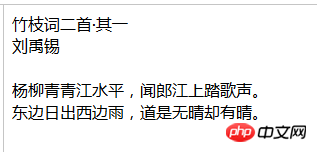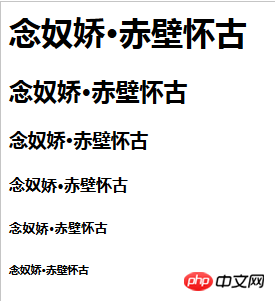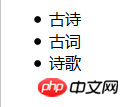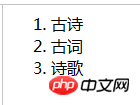 Web Front-end
Web Front-end
 HTML Tutorial
HTML Tutorial
 What tags does HTML have? A complete list of commonly used HTML tags
What tags does HTML have? A complete list of commonly used HTML tags
What tags does HTML have? A complete list of commonly used HTML tags
There are many tags in html, and each tag has different uses. The following article on php Chinese website will summarize the commonly used tags in html. Each tag will be followed by an example. Without further ado, let us Let’s take a look at the details.
##
Font tag, used to modify the text style in the display effecttextsize: Control the font size. Minimum 1 ~ maximum 7. If the setting range is not between 1 and 7, the setting is invalid color: Control the font color. Use English settings (for example: red, blue...) face: Control the font type. Only font types that exist in the system font library can be setExample:
<body> 东边日出<font color="green" size="50" face="宋体">西边雨</font> </body>
Effect:

Example:
竹枝词二首·其一<br/> 刘禹锡<br/><br/> 杨柳青青江水平,闻郎江上踏歌声。<br/> 东边日出西边雨,道是无晴却有晴。
Effect:

##
Paragraph tag is used to divide paragraphs in the display effect. And automatically add blank lines before and after the paragraphalign: The alignment of the paragraph content
The default is left, the content is left
Right
Center Centered
Example:<p align="center">黄鹤楼送孟浩然之广陵</p>
<p >故人西辞黄鹤楼,</p><p align="right">烟花三月下扬州。</p>
<p>孤帆远影碧空尽,</p><p align="right">唯见长江天际流。</p>

Title tag, used to divide titles in the display effect
Among them, is the largest, Example
:<h1>念奴娇·赤壁怀古</h1>
<h2 id="念奴娇-赤壁怀古">念奴娇·赤壁怀古</h2>
<h3 id="念奴娇-赤壁怀古">念奴娇·赤壁怀古</h3>
<h4 id="念奴娇-赤壁怀古">念奴娇·赤壁怀古</h4>
<h5 id="念奴娇-赤壁怀古">念奴娇·赤壁怀古</h5>
<h6 id="念奴娇-赤壁怀古">念奴娇·赤壁怀古</h6>
Copy after loginEffect:

Multiple spaces in the HTML source code will eventually be merged into one in the effect.
Space symbol, used to display a blank position in the effectExample:
php 中文网</br>
php 中文网
Copy after loginEffect:

HTML comments are used to annotate the HTML source code and are not displayed in the HTML effect.
can only be seen in the source code, and there is no format in the page display effect: example :
<!--html标签-->
Copy after loginEffect: It will not be displayed in the HTML effect display, and can only be seen in the source code
Picture tag
用于在页面效果中展示一张图片。
src:指明图片的路径。(必有属性)
图片路径的写法:
①内网路径:
绝对路径:文件在硬盘上的具体位置。【不建议使用】
例如:C:\ JavaWeb001_html\img\c_1.jpg
相对路径:从引入者所在目录出发。【建议使用相对路径】
例如:../img/c_1.jpg
../表示上一层目录
./表示当前目录
互联网路径:
必须前面加上http://
例如:http://www.baidu.com/xxx.jpgwidth:图片宽度
height:图片的高度
宽度和高度的设置:
默认单位是px,像素。例如:width=”400” 其实设置的是 width=”400px”。固定设置方式
百分比设置。例如:width=”50%”。 是父标签的百分比。 动态改变的。
示例:
<img src="/static/imghw/default1.png" data-src="../c_1.jpg" class="lazy" style="max-width:90%" style="max-width:90%"/ alt="What tags does HTML have? A complete list of commonly used HTML tags" >
<img src="/static/imghw/default1.png" data-src="../c_2.jpg" class="lazy" style="max-width:90%"/ alt="What tags does HTML have? A complete list of commonly used HTML tags" >
Copy after login列表标签
无序列表标签,用于在效果中定义一个无序列表
列表条目项标签,用于在效果中定义一个列表的条目
有序列表标签,用于在效果中定义一个有序列表
示例:
<ul>
<li>古诗</li>
<li>古词</li>
<li>诗歌</li>
</ul>Copy after login效果:

示例:
<ol>
<li>古诗</li>
<li>古词</li>
<li>诗歌</li>
</ol>Copy after login效果:

超链接标签
超链接标签,用于在效果中定义一个可以点击跳转的链接
href:超链接跳转的路径 (必有属性)
内网本机路径:相对路径和绝对路径
互联网路径:http://地址
本页:默认跳转到本页
超链接正常工作:①a标签中必须有内容
②a标签必须有href属性
示例:
<a herf="http://www.php.cn/">php中文网</a>
<a herf="demo html">demo</a>
Copy after login注意:
①a标签内容体,不仅仅是文字,也可以是其他内容,例如图片
②a标签的href属性,不仅仅可以链接到html上,也可以链接到其他文件上,例如图片
示例:
<a herf="demo html">
<img src="/static/imghw/default1.png" data-src="../img/c_1.jpg" class="lazy" / alt="What tags does HTML have? A complete list of commonly used HTML tags" >
</a>
Copy after login示例:
<a herf="../img/c_1.jpg" />链接到一张图片</a>
Copy after login表格标签
表格标签,用于在效果中定义一个表格
border:设置表格的边框粗细
width:设置表格的宽度
表格的行标签,用于在效果中定义一个表格行
表格的单元格标签,用于在效果中定义一个表格行中的单元格
表格的书写顺序:
步骤1:定义一个表格
步骤2:定义表格中的一行
步骤3:在表格一行中定义单元格
示例:
<table>
<tr>
<td>姓名</td>
<td>数学</td>
</tr>
<tr>
<td>A</td>
<td>100</td>
</tr>
</table>
Copy after login效果:

表格的表头单元格标签,用于在效果中定义一个表格行中的表头单元格
和 唯一区别: 内容 居中加粗示例:
<table boder="1px" width="100%">
<tr>
<th>姓名</th>
<th>数学</th>
</tr>
<tr>
<td>A</td>
<td>100</td>
</tr>
</table>
Copy after login效果:

单元格合并
或者 都有两个单元格合并属性:colspan:跨列合并单元格
rowspan:跨行合并单元格
合并步骤:
确定合并哪几个单元格,确定是跨列合并还是跨行合并
在第一个出现的单元格上书写 合并单元格属性
合并几个单元格,属性值就书写几
被合并的单元格必须删掉
示例:
<tr>
<td conspan="2">1</td>
<td>3</td>
<td>4</td>
</tr>
Copy after login示例:
<tr><td rowspan="2">6</td>
<td>7</td>
<td>8</td>
</tr>
<tr>
<td>12</td>
<td>15</td>
</tr>
Copy after login示例:
<tr>
<td conspan="2" rowspan="2">8</td>
<td>11</td>
</tr>
<tr>
<td>16</td>
</tr>
Copy after login块标签
行级的块标签,用于在效果中 一行上定义一个块,进行内容显示。
span有多少内容,就会占用多大空间。
Span不会自动换行
适用于少量数据展示
示例:
<span>哈哈哈哈哈</span>
<span>呵呵呵呵呵</span>
Copy after login效果:

块级的块标签,用于在效果中 定义一块,默认占满一行,进行内容的显示
默认占满一行
会自动换行
适用于大量数据展示
示例:
<div>哈哈哈哈哈</div>
<div>呵呵呵呵呵</div>
Copy after login
效果:

框架标签
框架标签:
The above is the detailed content of What tags does HTML have? A complete list of commonly used HTML tags. For more information, please follow other related articles on the PHP Chinese website!
Statement of this Website
The content of this article is voluntarily contributed by netizens, and the copyright belongs to the original author. This site does not assume corresponding legal responsibility. If you find any content suspected of plagiarism or infringement, please contact admin@php.cn

Hot AI Tools

Undresser.AI Undress
AI-powered app for creating realistic nude photos

AI Clothes Remover
Online AI tool for removing clothes from photos.

Undress AI Tool
Undress images for free

Clothoff.io
AI clothes remover

AI Hentai Generator
Generate AI Hentai for free.

Hot Article
R.E.P.O. Energy Crystals Explained and What They Do (Yellow Crystal)
2 weeks ago
By 尊渡假赌尊渡假赌尊渡假赌
Repo: How To Revive Teammates
4 weeks ago
By 尊渡假赌尊渡假赌尊渡假赌
Hello Kitty Island Adventure: How To Get Giant Seeds
3 weeks ago
By 尊渡假赌尊渡假赌尊渡假赌
How Long Does It Take To Beat Split Fiction?
3 weeks ago
By DDD
R.E.P.O. Save File Location: Where Is It & How to Protect It?
3 weeks ago
By DDD

Hot Tools

Notepad++7.3.1
Easy-to-use and free code editor

SublimeText3 Chinese version
Chinese version, very easy to use

Zend Studio 13.0.1
Powerful PHP integrated development environment

Dreamweaver CS6
Visual web development tools

SublimeText3 Mac version
God-level code editing software (SublimeText3)

Hot Topics
 Table Border in HTML
Sep 04, 2024 pm 04:49 PM
Table Border in HTML
Sep 04, 2024 pm 04:49 PM
Guide to Table Border in HTML. Here we discuss multiple ways for defining table-border with examples of the Table Border in HTML.
 Nested Table in HTML
Sep 04, 2024 pm 04:49 PM
Nested Table in HTML
Sep 04, 2024 pm 04:49 PM
This is a guide to Nested Table in HTML. Here we discuss how to create a table within the table along with the respective examples.
 HTML margin-left
Sep 04, 2024 pm 04:48 PM
HTML margin-left
Sep 04, 2024 pm 04:48 PM
Guide to HTML margin-left. Here we discuss a brief overview on HTML margin-left and its Examples along with its Code Implementation.
 HTML Table Layout
Sep 04, 2024 pm 04:54 PM
HTML Table Layout
Sep 04, 2024 pm 04:54 PM
Guide to HTML Table Layout. Here we discuss the Values of HTML Table Layout along with the examples and outputs n detail.
 Moving Text in HTML
Sep 04, 2024 pm 04:45 PM
Moving Text in HTML
Sep 04, 2024 pm 04:45 PM
Guide to Moving Text in HTML. Here we discuss an introduction, how marquee tag work with syntax and examples to implement.
 HTML Ordered List
Sep 04, 2024 pm 04:43 PM
HTML Ordered List
Sep 04, 2024 pm 04:43 PM
Guide to the HTML Ordered List. Here we also discuss introduction of HTML Ordered list and types along with their example respectively
 How do you parse and process HTML/XML in PHP?
Feb 07, 2025 am 11:57 AM
How do you parse and process HTML/XML in PHP?
Feb 07, 2025 am 11:57 AM
This tutorial demonstrates how to efficiently process XML documents using PHP. XML (eXtensible Markup Language) is a versatile text-based markup language designed for both human readability and machine parsing. It's commonly used for data storage an
 HTML onclick Button
Sep 04, 2024 pm 04:49 PM
HTML onclick Button
Sep 04, 2024 pm 04:49 PM
Guide to HTML onclick Button. Here we discuss their introduction, working, examples and onclick Event in various events respectively.
See all articles

Example
:<h1>念奴娇·赤壁怀古</h1> <h2 id="念奴娇-赤壁怀古">念奴娇·赤壁怀古</h2> <h3 id="念奴娇-赤壁怀古">念奴娇·赤壁怀古</h3> <h4 id="念奴娇-赤壁怀古">念奴娇·赤壁怀古</h4> <h5 id="念奴娇-赤壁怀古">念奴娇·赤壁怀古</h5> <h6 id="念奴娇-赤壁怀古">念奴娇·赤壁怀古</h6>

Multiple spaces in the HTML source code will eventually be merged into one in the effect.
Space symbol, used to display a blank position in the effectExample:
php 中文网</br> php 中文网

are used to annotate the HTML source code and are not displayed in the HTML effect.
can only be seen in the source code, and there is no format in the page display effect:example :
<!--html标签-->
Picture tag
用于在页面效果中展示一张图片。 src:指明图片的路径。(必有属性) 图片路径的写法: ①内网路径: 绝对路径:文件在硬盘上的具体位置。【不建议使用】 例如:C:\ JavaWeb001_html\img\c_1.jpg 相对路径:从引入者所在目录出发。【建议使用相对路径】 例如:../img/c_1.jpg ../表示上一层目录 ./表示当前目录 互联网路径: 必须前面加上http:// width:图片宽度 height:图片的高度 宽度和高度的设置: 默认单位是px,像素。例如:width=”400” 其实设置的是 width=”400px”。固定设置方式 百分比设置。例如:width=”50%”。 是父标签的百分比。 动态改变的。 示例: 列表标签 无序列表标签,用于在效果中定义一个无序列表 列表条目项标签,用于在效果中定义一个列表的条目 有序列表标签,用于在效果中定义一个有序列表 示例: 效果: 示例: 效果: 超链接标签 超链接标签,用于在效果中定义一个可以点击跳转的链接 href:超链接跳转的路径 (必有属性) 内网本机路径:相对路径和绝对路径 互联网路径:http://地址 本页:默认跳转到本页 超链接正常工作:①a标签中必须有内容 ②a标签必须有href属性 示例: 注意: ①a标签内容体,不仅仅是文字,也可以是其他内容,例如图片 ②a标签的href属性,不仅仅可以链接到html上,也可以链接到其他文件上,例如图片 示例: 示例: 表格标签 表格标签,用于在效果中定义一个表格 border:设置表格的边框粗细 width:设置表格的宽度 表格的行标签,用于在效果中定义一个表格行 表格的单元格标签,用于在效果中定义一个表格行中的单元格 表格的书写顺序: 步骤1:定义一个表格 
<img src="/static/imghw/default1.png" data-src="../c_1.jpg" class="lazy" style="max-width:90%" style="max-width:90%"/ alt="What tags does HTML have? A complete list of commonly used HTML tags" >
<img src="/static/imghw/default1.png" data-src="../c_2.jpg" class="lazy" style="max-width:90%"/ alt="What tags does HTML have? A complete list of commonly used HTML tags" >
<ul>
<li>古诗</li>
<li>古词</li>
<li>诗歌</li>
</ul>
<ol>
<li>古诗</li>
<li>古词</li>
<li>诗歌</li>
</ol>
<a herf="http://www.php.cn/">php中文网</a>
<a herf="demo html">demo</a>
<a herf="demo html">
<img src="/static/imghw/default1.png" data-src="../img/c_1.jpg" class="lazy" / alt="What tags does HTML have? A complete list of commonly used HTML tags" >
</a>
<a herf="../img/c_1.jpg" />链接到一张图片</a>
步骤2:定义表格中的一行
步骤3:在表格一行中定义单元格
示例:
<table> <tr> <td>姓名</td> <td>数学</td> </tr> <tr> <td>A</td> <td>100</td> </tr> </table>
效果:

表格的表头单元格标签,用于在效果中定义一个表格行中的表头单元格
示例:
<table boder="1px" width="100%"> <tr> <th>姓名</th> <th>数学</th> </tr> <tr> <td>A</td> <td>100</td> </tr> </table>
效果:

单元格合并
colspan:跨列合并单元格
rowspan:跨行合并单元格
合并步骤:
确定合并哪几个单元格,确定是跨列合并还是跨行合并
在第一个出现的单元格上书写 合并单元格属性
合并几个单元格,属性值就书写几
被合并的单元格必须删掉
示例:
<tr> <td conspan="2">1</td> <td>3</td> <td>4</td> </tr>
示例:
<tr><td rowspan="2">6</td> <td>7</td> <td>8</td> </tr> <tr> <td>12</td> <td>15</td> </tr>
示例:
<tr> <td conspan="2" rowspan="2">8</td> <td>11</td> </tr> <tr> <td>16</td> </tr>
块标签
行级的块标签,用于在效果中 一行上定义一个块,进行内容显示。
span有多少内容,就会占用多大空间。
Span不会自动换行
适用于少量数据展示
示例:
<span>哈哈哈哈哈</span> <span>呵呵呵呵呵</span>
效果:

块级的块标签,用于在效果中 定义一块,默认占满一行,进行内容的显示
默认占满一行
会自动换行
适用于大量数据展示
示例:
<div>哈哈哈哈哈</div> <div>呵呵呵呵呵</div>
效果:

框架标签
框架标签:
The above is the detailed content of What tags does HTML have? A complete list of commonly used HTML tags. For more information, please follow other related articles on the PHP Chinese website!

Hot AI Tools

Undresser.AI Undress
AI-powered app for creating realistic nude photos

AI Clothes Remover
Online AI tool for removing clothes from photos.

Undress AI Tool
Undress images for free

Clothoff.io
AI clothes remover

AI Hentai Generator
Generate AI Hentai for free.

Hot Article

Hot Tools

Notepad++7.3.1
Easy-to-use and free code editor

SublimeText3 Chinese version
Chinese version, very easy to use

Zend Studio 13.0.1
Powerful PHP integrated development environment

Dreamweaver CS6
Visual web development tools

SublimeText3 Mac version
God-level code editing software (SublimeText3)

Hot Topics
 Table Border in HTML
Sep 04, 2024 pm 04:49 PM
Table Border in HTML
Sep 04, 2024 pm 04:49 PM
Guide to Table Border in HTML. Here we discuss multiple ways for defining table-border with examples of the Table Border in HTML.
 Nested Table in HTML
Sep 04, 2024 pm 04:49 PM
Nested Table in HTML
Sep 04, 2024 pm 04:49 PM
This is a guide to Nested Table in HTML. Here we discuss how to create a table within the table along with the respective examples.
 HTML margin-left
Sep 04, 2024 pm 04:48 PM
HTML margin-left
Sep 04, 2024 pm 04:48 PM
Guide to HTML margin-left. Here we discuss a brief overview on HTML margin-left and its Examples along with its Code Implementation.
 HTML Table Layout
Sep 04, 2024 pm 04:54 PM
HTML Table Layout
Sep 04, 2024 pm 04:54 PM
Guide to HTML Table Layout. Here we discuss the Values of HTML Table Layout along with the examples and outputs n detail.
 Moving Text in HTML
Sep 04, 2024 pm 04:45 PM
Moving Text in HTML
Sep 04, 2024 pm 04:45 PM
Guide to Moving Text in HTML. Here we discuss an introduction, how marquee tag work with syntax and examples to implement.
 HTML Ordered List
Sep 04, 2024 pm 04:43 PM
HTML Ordered List
Sep 04, 2024 pm 04:43 PM
Guide to the HTML Ordered List. Here we also discuss introduction of HTML Ordered list and types along with their example respectively
 How do you parse and process HTML/XML in PHP?
Feb 07, 2025 am 11:57 AM
How do you parse and process HTML/XML in PHP?
Feb 07, 2025 am 11:57 AM
This tutorial demonstrates how to efficiently process XML documents using PHP. XML (eXtensible Markup Language) is a versatile text-based markup language designed for both human readability and machine parsing. It's commonly used for data storage an
 HTML onclick Button
Sep 04, 2024 pm 04:49 PM
HTML onclick Button
Sep 04, 2024 pm 04:49 PM
Guide to HTML onclick Button. Here we discuss their introduction, working, examples and onclick Event in various events respectively.





